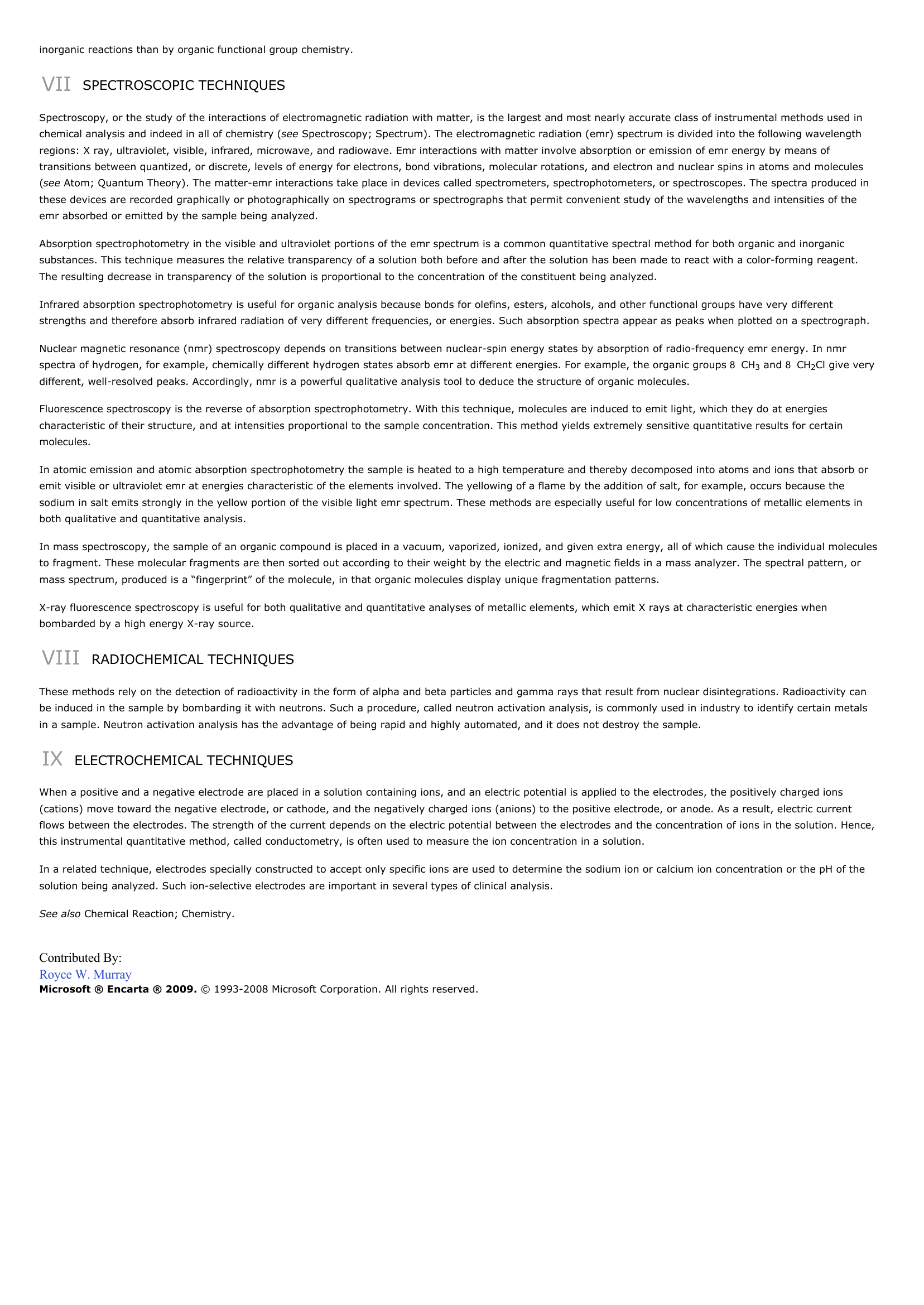Chemical Analysis - chemistry.
Publié le 11/05/2013

Extrait du document
«
inorganic reactions than by organic functional group chemistry.
VII SPECTROSCOPIC TECHNIQUES
Spectroscopy, or the study of the interactions of electromagnetic radiation with matter, is the largest and most nearly accurate class of instrumental methods used inchemical analysis and indeed in all of chemistry ( see Spectroscopy; Spectrum).
The electromagnetic radiation (emr) spectrum is divided into the following wavelength regions: X ray, ultraviolet, visible, infrared, microwave, and radiowave.
Emr interactions with matter involve absorption or emission of emr energy by means oftransitions between quantized, or discrete, levels of energy for electrons, bond vibrations, molecular rotations, and electron and nuclear spins in atoms and molecules(see Atom; Quantum Theory).
The matter-emr interactions take place in devices called spectrometers, spectrophotometers, or spectroscopes.
The spectra produced in these devices are recorded graphically or photographically on spectrograms or spectrographs that permit convenient study of the wavelengths and intensities of theemr absorbed or emitted by the sample being analyzed.
Absorption spectrophotometry in the visible and ultraviolet portions of the emr spectrum is a common quantitative spectral method for both organic and inorganicsubstances.
This technique measures the relative transparency of a solution both before and after the solution has been made to react with a color-forming reagent.The resulting decrease in transparency of the solution is proportional to the concentration of the constituent being analyzed.
Infrared absorption spectrophotometry is useful for organic analysis because bonds for olefins, esters, alcohols, and other functional groups have very differentstrengths and therefore absorb infrared radiation of very different frequencies, or energies.
Such absorption spectra appear as peaks when plotted on a spectrograph.
Nuclear magnetic resonance (nmr) spectroscopy depends on transitions between nuclear-spin energy states by absorption of radio-frequency emr energy.
In nmrspectra of hydrogen, for example, chemically different hydrogen states absorb emr at different energies.
For example, the organic groups 8CH3 and 8CH2Cl give very different, well-resolved peaks.
Accordingly, nmr is a powerful qualitative analysis tool to deduce the structure of organic molecules.
Fluorescence spectroscopy is the reverse of absorption spectrophotometry.
With this technique, molecules are induced to emit light, which they do at energiescharacteristic of their structure, and at intensities proportional to the sample concentration.
This method yields extremely sensitive quantitative results for certainmolecules.
In atomic emission and atomic absorption spectrophotometry the sample is heated to a high temperature and thereby decomposed into atoms and ions that absorb oremit visible or ultraviolet emr at energies characteristic of the elements involved.
The yellowing of a flame by the addition of salt, for example, occurs because thesodium in salt emits strongly in the yellow portion of the visible light emr spectrum.
These methods are especially useful for low concentrations of metallic elements inboth qualitative and quantitative analysis.
In mass spectroscopy, the sample of an organic compound is placed in a vacuum, vaporized, ionized, and given extra energy, all of which cause the individual moleculesto fragment.
These molecular fragments are then sorted out according to their weight by the electric and magnetic fields in a mass analyzer.
The spectral pattern, ormass spectrum, produced is a “fingerprint” of the molecule, in that organic molecules display unique fragmentation patterns.
X-ray fluorescence spectroscopy is useful for both qualitative and quantitative analyses of metallic elements, which emit X rays at characteristic energies whenbombarded by a high energy X-ray source.
VIII RADIOCHEMICAL TECHNIQUES
These methods rely on the detection of radioactivity in the form of alpha and beta particles and gamma rays that result from nuclear disintegrations.
Radioactivity canbe induced in the sample by bombarding it with neutrons.
Such a procedure, called neutron activation analysis, is commonly used in industry to identify certain metalsin a sample.
Neutron activation analysis has the advantage of being rapid and highly automated, and it does not destroy the sample.
IX ELECTROCHEMICAL TECHNIQUES
When a positive and a negative electrode are placed in a solution containing ions, and an electric potential is applied to the electrodes, the positively charged ions(cations) move toward the negative electrode, or cathode, and the negatively charged ions (anions) to the positive electrode, or anode.
As a result, electric currentflows between the electrodes.
The strength of the current depends on the electric potential between the electrodes and the concentration of ions in the solution.
Hence,this instrumental quantitative method, called conductometry, is often used to measure the ion concentration in a solution.
In a related technique, electrodes specially constructed to accept only specific ions are used to determine the sodium ion or calcium ion concentration or the pH of thesolution being analyzed.
Such ion-selective electrodes are important in several types of clinical analysis.
See also Chemical Reaction; Chemistry.
Contributed By:Royce W.
MurrayMicrosoft ® Encarta ® 2009. © 1993-2008 Microsoft Corporation.
All rights reserved..
»
↓↓↓ APERÇU DU DOCUMENT ↓↓↓
Liens utiles
- Chemical Elements - chemistry.
- Chemical Reaction - chemistry.
- « Life is a self-replicating, evoluing system based on organic chemistry » Qu’est ce qui est vivant ?
- Flirtation Analysis
- ICI [Imperial Chemical Industries] (entreprise).









